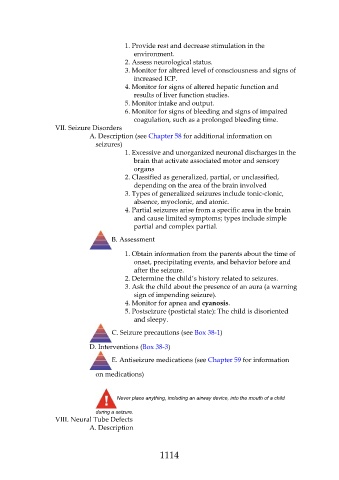Page 1114 - Saunders Comprehensive Review For NCLEX-RN
P. 1114
1. Provide rest and decrease stimulation in the
environment.
2. Assess neurological status.
3. Monitor for altered level of consciousness and signs of
increased ICP.
4. Monitor for signs of altered hepatic function and
results of liver function studies.
5. Monitor intake and output.
6. Monitor for signs of bleeding and signs of impaired
coagulation, such as a prolonged bleeding time.
VII. Seizure Disorders
A. Description (see Chapter 58 for additional information on
seizures)
1. Excessive and unorganized neuronal discharges in the
brain that activate associated motor and sensory
organs
2. Classified as generalized, partial, or unclassified,
depending on the area of the brain involved
3. Types of generalized seizures include tonic-clonic,
absence, myoclonic, and atonic.
4. Partial seizures arise from a specific area in the brain
and cause limited symptoms; types include simple
partial and complex partial.
B. Assessment
1. Obtain information from the parents about the time of
onset, precipitating events, and behavior before and
after the seizure.
2. Determine the child’s history related to seizures.
3. Ask the child about the presence of an aura (a warning
sign of impending seizure).
4. Monitor for apnea and cyanosis.
5. Postseizure (postictal state): The child is disoriented
and sleepy.
C. Seizure precautions (see Box 38-1)
D. Interventions (Box 38-3)
E. Antiseizure medications (see Chapter 59 for information
on medications)
Never place anything, including an airway device, into the mouth of a child
during a seizure.
VIII. Neural Tube Defects
A. Description
1114

